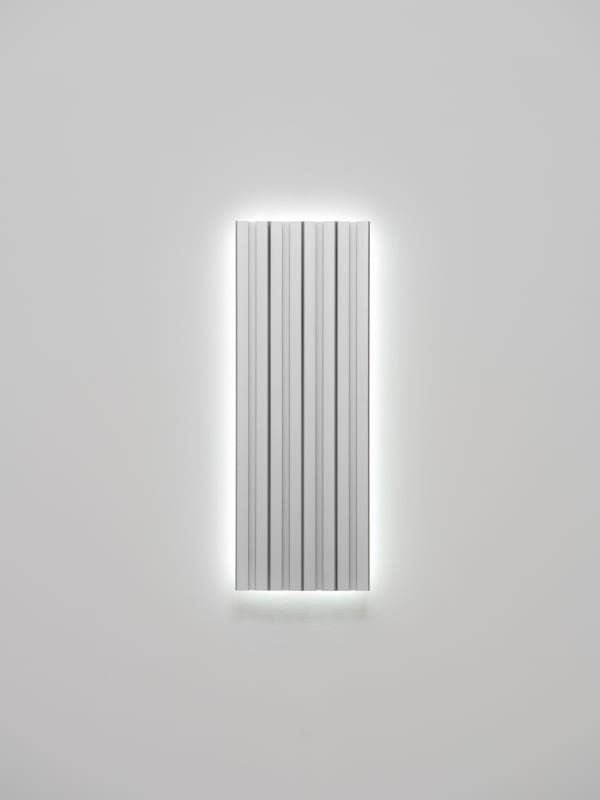Liam Gillick: The Alterants
Gallery Baton is pleased to present The Alterants, a solo exhibition by Liam Gillick (b. 1964) at the gallery’s Hannam-dong space in Seoul from 6 October through 11 November. Gillick is an important and influential figure in contemporary art who made significant contributions to the genesis and establishment of the term ‘Relational Aesthetics’. His practice spans multi-disciplined fields, and has developed beyond artworks and public installations to critical writing about the artist’s role in society. In his third solo exhibition with the gallery, a series of new wall-mounted sculptures and experimental wall graphic works are premiered.
There is an aesthetic gap between the reality and representation of advanced production. This exhibition introduces three unresolved artistic elements that operate alongside each other, in a series of contradictory parallels. The works address the gap between what is desired, what is produced and how it is described. Abstract wall based sculptures provide their own illumination. A new symbolic language chases after production processes. Wall mounted panels act as objects that suggest universal references in an echo of the platinum “metres” of revolutionary France, that operated as physical reference points for the entire metric system.
The new wall-mounted sculptures are placed direct relationship with enigmatic graphic elements. These wall works further an interest in developing forms of contemporary abstraction as modes of production and consumption continue to evolve and mutate. The wall graphics comments upon the abstract works by suggesting a system of interpretation – a new visual language in parallel to the structures. The wall works are constructed from lightweight aluminium t-slot extrusions that are commonly used for the construction of laboratory rigs, CNC machines, and advanced production lines. These illuminated extrusions create self-contained systems evocative of the mute, smooth flows of advanced production in stasis.
So, each aluminum wall structure is combined with a thought bubble containing a single curving mark – somewhere between an attempt at writing and the depiction of an elusive form. While the wall structures are clean, stark and direct – their “thoughts” are complex, interwoven and elusive. The curving marks are a visual language consciously derived from attempts in Europe, notably Austria and Germany, in the 1920s to rationalize understanding of production, consumption and social development.
Isotypes (the International System of Typographic Picture Education) were developed by Otto Neurath in 1920s Austria. Originally known as the Vienna Method, the graphics for these early modern pictograms were created by German artist Gerd Arntz. The original system was devised to present complex statistical information in a simple pictorial form. So coal production might be expressed as a row of simple images of a man wearing a helmet and carrying a shovel. Relative car production of different nations might be shown as lines of repeated simple images of automobiles. This system is immediately comprehensible and recognizable today – extended and elaborated over the last 100 years and leading to the simple icons that we encounter everywhere. When creating info-graphics using Isotypes a key member of the team was the “transformer”. It was the transformers role to convert statistical data into clear visual form. The abstract forms in this exhibition represent a more elusive visual language that might represent new advanced forms of production today[1]. Rather than the simple, easy to read Isotypes that were drawn by Arntz these new ones are unresolved and non-representational and give no direct equivalence the complexity of that which is being produced today. This reflects the difficulty of containing and understanding the scope of contemporary production. It is notable that in the European Commission report on advanced technologies that they have abandoned isotypes in favor of simple circles and squares.
This exhibition continues an interest in the intersections of productive human life. The works in the exhibition suggest the necessity for a new kind of transformer who can truly understand the semiotic complexities of production and consumption today. This new transformer is The Alterant of the title. In this case, the visitor to the exhibition who can speculate on the relationship between new highly elusive isotypes and the afffects that occur inbetween and around advanced production. An embyonic info-graphical language that is incapable of providing clear information while at the same time suggesting the necessity to picture complex global flows more accurately. An expression of rationalized production in creative form.
[1] According to the European Commission, these include: Advanced Manufacturing Technology, Advanced Materials, Artificial Intelligence, Augmented/Virtual Reality, Big Data, Blockchain, Connectivity, Cloud computing, Industrial Biotechnology, Internet of Things, Micro- and Nanoelectronics, Photonics, Mobility, Robotics and Security.
Advanced Technologies for Industry – Methodological report, European Commission, 2021
-
 Liam GillickAutomatically Attributable Direction, 2023LED, T-slot aluminum extrusion9 x 100 x 7.5 cm
Liam GillickAutomatically Attributable Direction, 2023LED, T-slot aluminum extrusion9 x 100 x 7.5 cm -
 Liam GillickDivine Frontline Knowledge , 2023vinyldimensions variable
Liam GillickDivine Frontline Knowledge , 2023vinyldimensions variable -
 Liam GillickContinuous Improvement Conditions, 2023LED, T-slot aluminum extrusion100 x 9 x 7.5 cm
Liam GillickContinuous Improvement Conditions, 2023LED, T-slot aluminum extrusion100 x 9 x 7.5 cm -
 Liam GillickLush Edge Protocol, 2023vinyldimensions variable
Liam GillickLush Edge Protocol, 2023vinyldimensions variable -
 Liam GillickPerfection Rates, 2023LED, T-slot aluminum extrusion50 x 18 x 7.5 cm
Liam GillickPerfection Rates, 2023LED, T-slot aluminum extrusion50 x 18 x 7.5 cm -
 Liam GillickDewy Visible Template, 2023screenprinted Dibond aluminium, tray frame100 x 100 x 3 cm
Liam GillickDewy Visible Template, 2023screenprinted Dibond aluminium, tray frame100 x 100 x 3 cm







